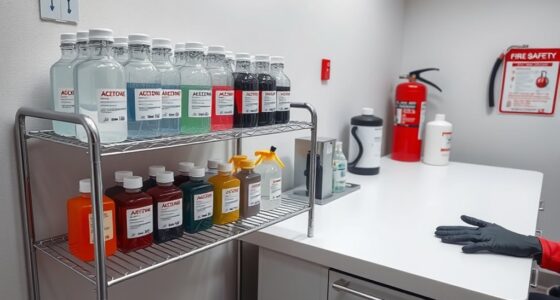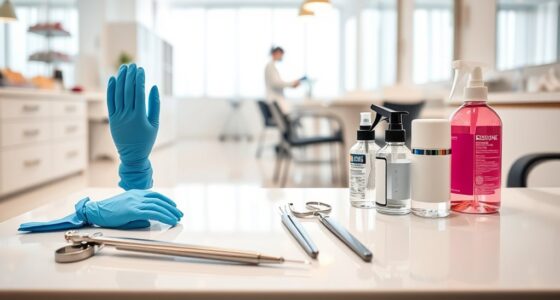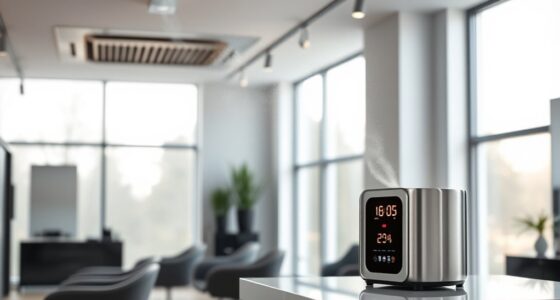To prevent cross-contamination and avoid double dipping, always use disposable applicators or thoroughly clean and sterilize reusable tools between clients. Never dip the same tool into products or onto multiple clients’ skin without proper sanitation. Maintain a strict hygiene routine by regularly disinfecting surfaces and washing your hands. Staying vigilant with these practices protects your clients and your reputation. Keep going to discover more essential tips for maintaining a safe and sanitary salon environment.
Key Takeaways
- Use disposable applicators or thoroughly sterilize reusable tools between clients to prevent cross-contamination.
- Avoid double dipping by never re-dipping tools or applicators into products after contact with clients.
- Implement strict hand hygiene and wear gloves when handling tools and products to minimize bacteria transfer.
- Regularly disinfect all surfaces, chairs, and workstations after every client to maintain a sterile environment.
- Train staff consistently on proper sanitation protocols and emphasize the importance of preventing double dipping.

Maintaining a clean and sanitized salon environment is crucial to prevent cross-contamination and protect your clients’ health. As a salon professional, you know that implementing strict sanitation protocols is essential. These protocols aren’t just guidelines; they’re the foundation of a safe and trustworthy salon. One of the most critical aspects of these protocols is tool sterilization. Properly sterilizing tools ensures that bacteria, fungi, and viruses don’t transfer from one client to another, reducing the risk of infections and complications.
When it comes to sanitation protocols, consistency is key. You should develop a routine that covers every aspect of your work, from washing your hands thoroughly before each client to disinfecting surfaces regularly. Make sure that your tools are cleaned immediately after use. Use appropriate cleaning solutions to remove debris and organic matter, which can harbor pathogens. Once cleaned, sterilize your tools using an autoclave or other approved sterilization methods. Never skip this step, as unsterilized tools are a common source of cross-contamination.
Consistency in cleaning and sterilizing tools is essential to prevent cross-contamination and ensure client safety.
Double dipping is a major mistake that many salons inadvertently make, and it can be dangerous. If you dip your brush or spatula into a product container, then dip it again without cleaning or replacing it, you risk transferring contaminants back into the product or onto your client’s skin. To prevent this, always use disposable applicators when possible, or thoroughly clean and sterilize reusable tools between clients. Encourage your staff to follow this practice diligently to maintain high hygiene standards.
You should also educate your clients about the importance of hygiene. For example, advise them to bring their own personal tools or to request freshly sterilized instruments. Maintain a clean workspace by disinfecting chairs, countertops, and other frequently touched surfaces after each client. This ongoing effort reinforces your commitment to safety and helps prevent cross-contamination from environmental sources.
Additionally, investing in high-quality gear and equipment for sanitation, such as reliable sterilizers and disinfectants, can streamline your processes and ensure thorough cleanliness. Lastly, stay updated on the latest sanitation guidelines from health authorities and industry associations. Regular training sessions will remind you and your team of best practices, including proper tool sterilization and avoiding double dipping. By adhering to strict sanitation protocols, using effective sterilization methods, and fostering a culture of cleanliness, you protect your clients’ health and enhance your salon’s reputation. Remember, every step you take toward better sanitation is a step toward safer, healthier service that clients will trust and appreciate.
Frequently Asked Questions
What Are the Most Common Sources of Cross-Contamination in Salons?
You should be aware that common sources of cross-contamination in salons include improperly sanitized tools, towels, and workstations. Failing to follow proper sanitization protocols can allow bacteria and fungi to spread between clients. To prevent this, you need to strictly adhere to sanitization protocols, regularly disinfect surfaces, and avoid double-dipping tools. These practices are essential for cross-contamination prevention and ensuring a safe environment for everyone.
How Often Should Salon Tools Be Sterilized?
They say, “A stitch in time saves nine,” and that’s true for salon tools too. You should sterilize your tools after each client to guarantee proper sanitation. Maintain a strict sanitation schedule, and regularly check your sterilization equipment. Consistent sterilization frequency prevents cross-contamination and keeps your clients safe. Don’t wait until problems arise—make sterilization a priority every day to uphold hygiene standards and protect everyone’s health.
Are Disposable Tools More Hygienic Than Reusable Ones?
Disposable tools are generally more hygienic than reusable ones because they are single-use, ensuring no cross-contamination. When you opt for single-use tools, you meet higher hygiene standards, reducing the risk of bacteria transfer. This eliminates the need for sterilization between clients, saving time and effort. Using disposable tools demonstrates your commitment to client safety and hygiene, making it a smart choice in maintaining a clean, professional salon environment.
What Training Is Recommended for Staff on Hygiene Practices?
You should guarantee your staff receives extensive staff training on hygiene protocols to maintain a safe salon environment. Proper training covers hand hygiene, tool sterilization, and proper sanitation procedures. Regular updates reinforce best practices, reducing cross-contamination risks. By prioritizing ongoing education on hygiene protocols, you help your team uphold high standards, protect clients, and prevent issues like double dipping, ultimately creating a clean, professional, and trustworthy salon setting.
How Can Clients Identify a Salon That Follows Proper Sanitation Protocols?
Imagine stepping into a clean, well-orchestrated symphony of sanitation. You can spot a salon with proper protocols by checking for visible hygiene certification signs. Look for organized tools and fresh, disposable items. Trust your instincts and listen to customer feedback—happy clients often reflect high standards. A salon committed to sanitation makes safety your top priority, turning your visit into a stress-free, sparkling experience.
Conclusion
Think of your salon as a well-tended garden. When you avoid cross-contamination, you’re like a diligent gardener, carefully pruning and watering without spreading pests or disease. Each tool and surface becomes a healthy plant, thriving in its own space. By staying vigilant, you guarantee your salon blossoms with cleanliness and safety. Remember, a little extra care keeps your clients happy and your reputation thriving—because a healthy garden begins with a mindful gardener.









